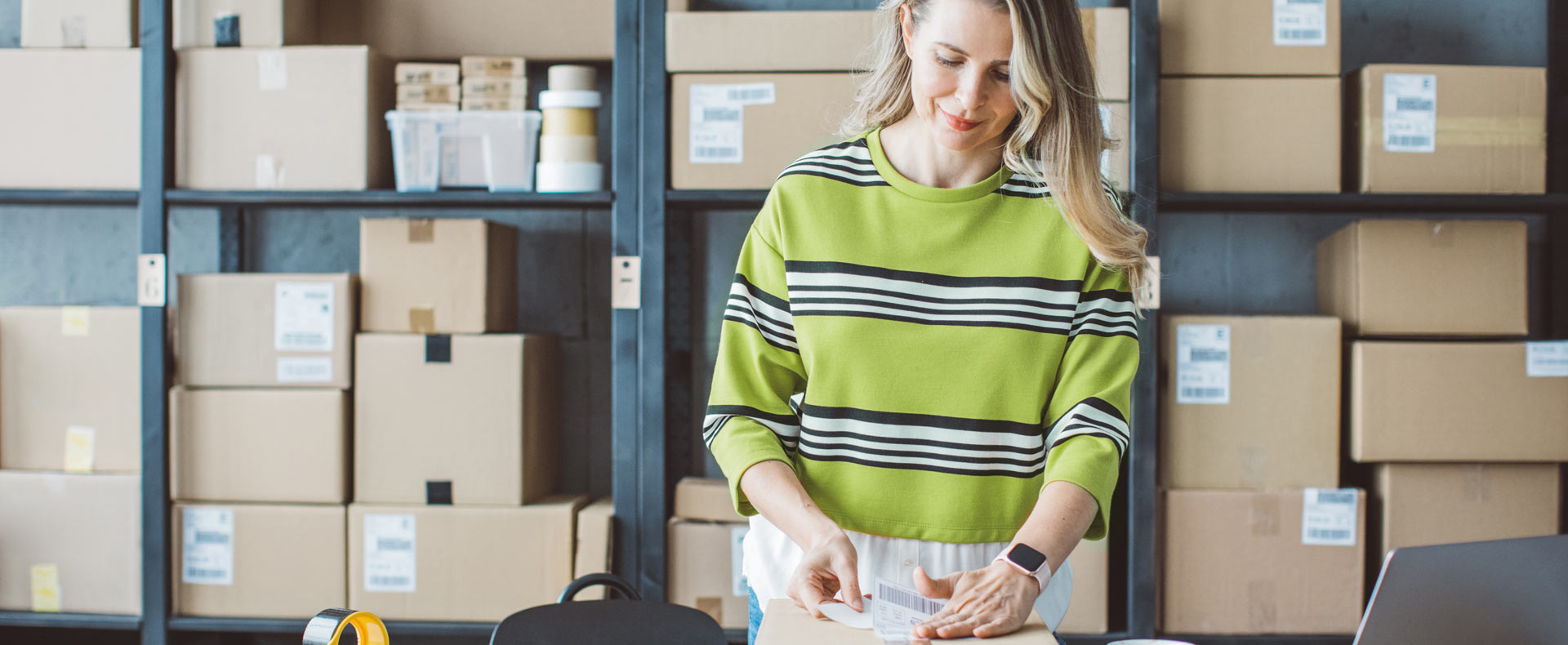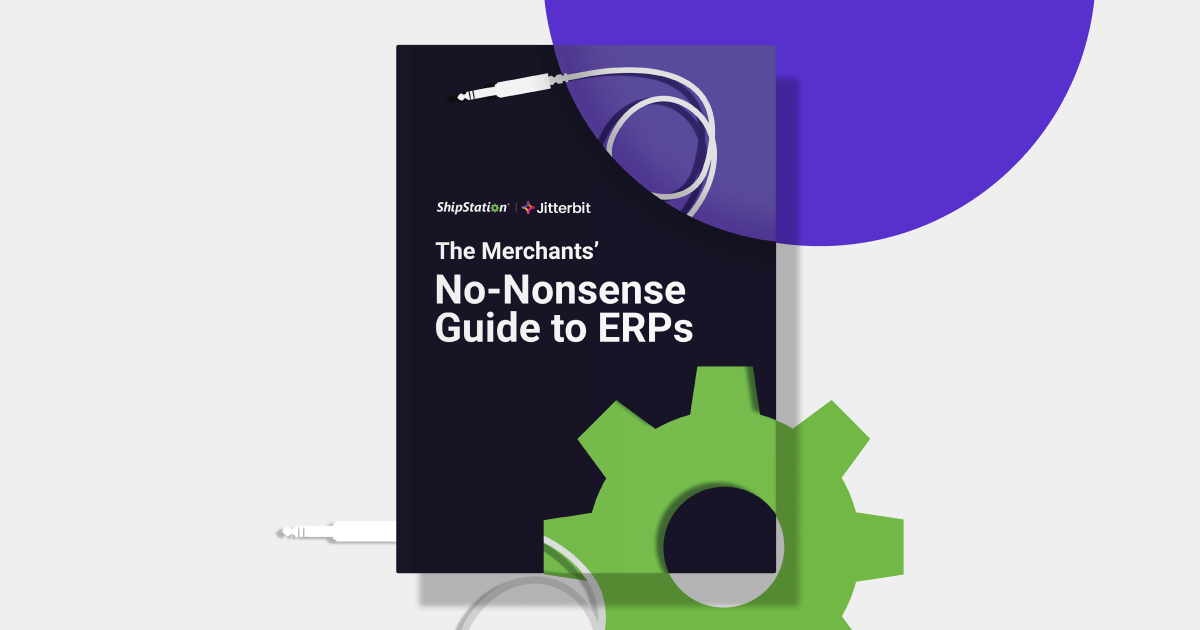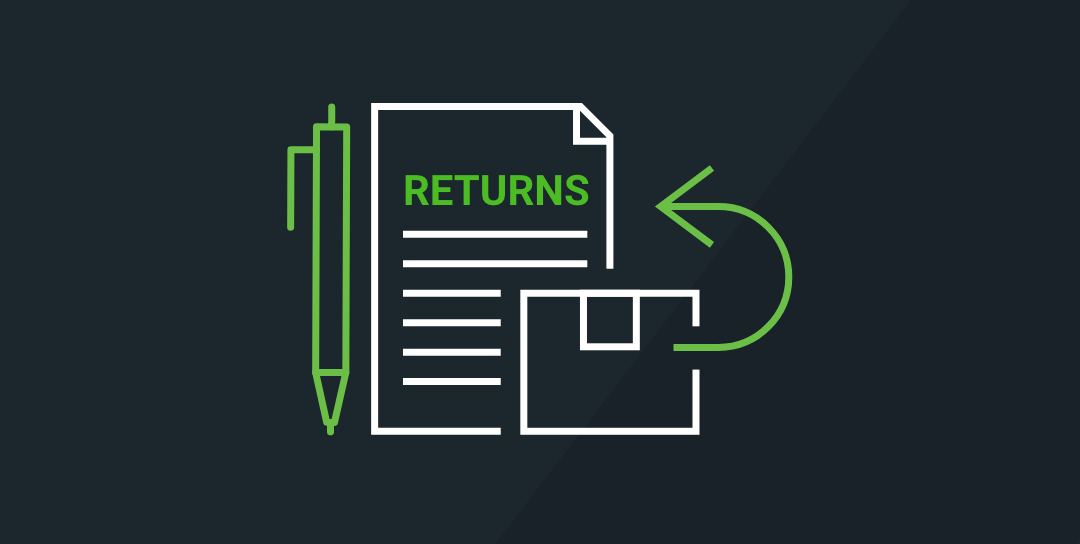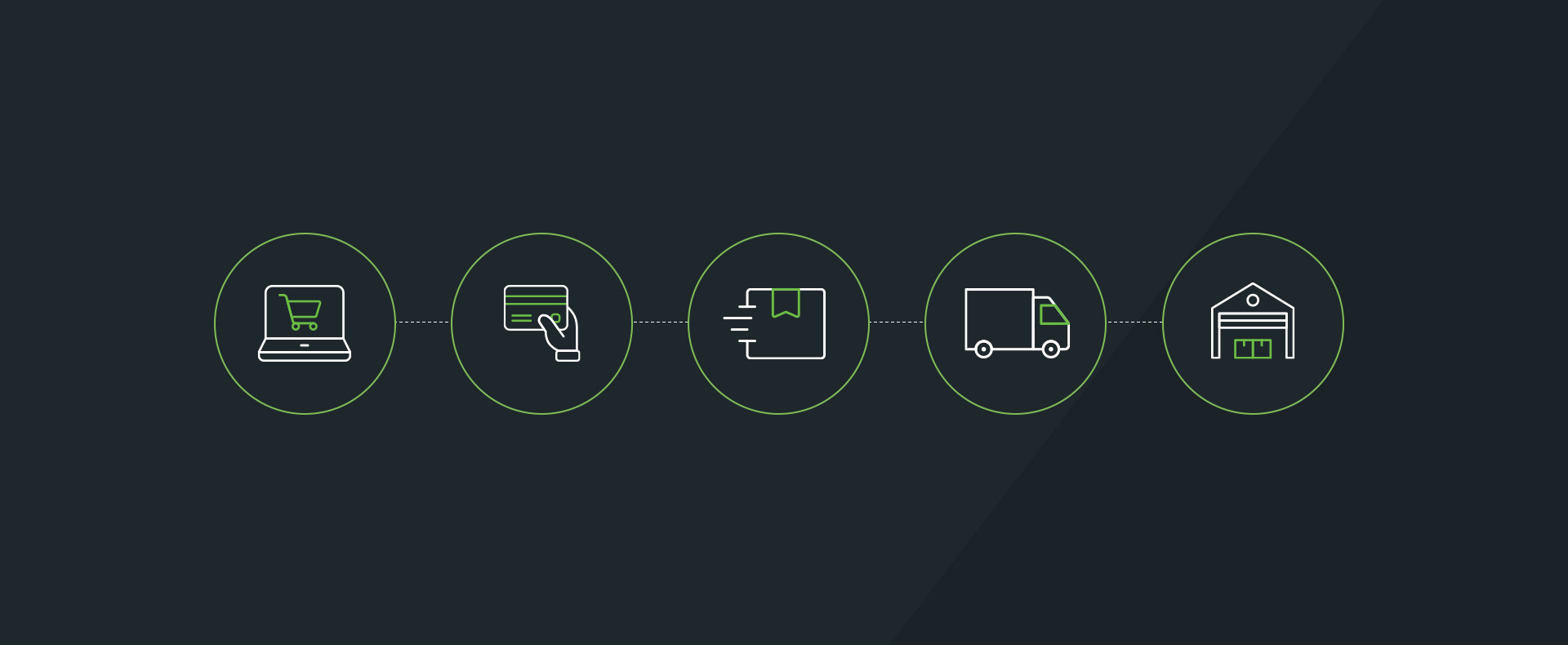How the Try Before You Buy Option Can Impact Your Online Business
Brick and mortar stores have long had an advantage over ecommerce stores. That advantage is a customer’s ability to try on and use items before buying. In the last few years, though, online merchants have begun offering more advanced try before you buy options. This trend is growing, especially for companies specializing in apparel and accessories.
Consumer Interest in Try Before You Buy
A recent survey confirms strong consumer interest in the try before you buy model. A whopping 37% of online shoppers surveyed preferred it over any “traditional payment method”.
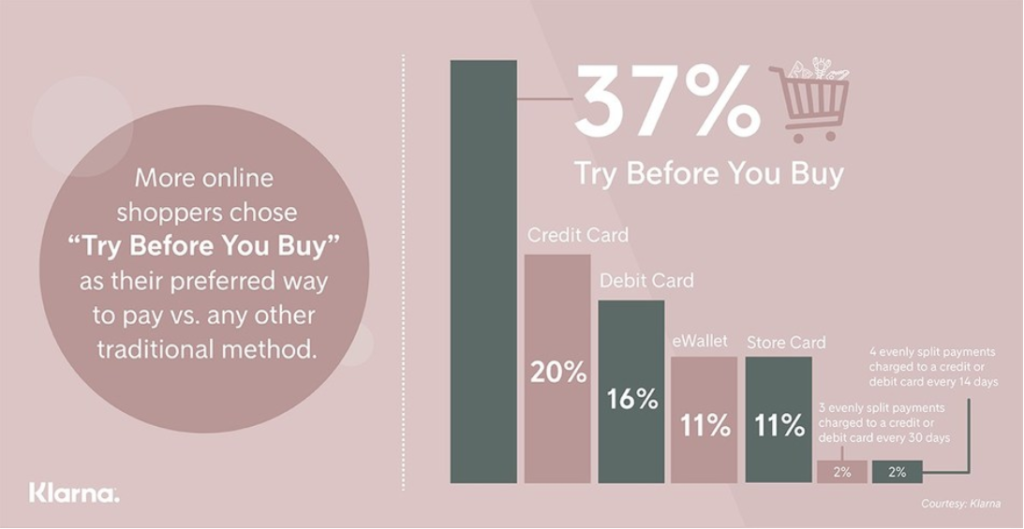
Additionally, the survey shows:
- “71 percent of those surveyed indicated they would use this payment method if it was offered” (PRNewswire.com)
- “71 percent of respondents stated they would be moderately, very or completely likely to choose a retailer offering a “Try Before You Buy” option over one who did not offer this option” (PRNewswire.com)
- “69 percent of consumers surveyed said they would be moderately, very, or completely likely to buy more items from online merchants offering this payment option.” (PRNewswire.com)
How the Try Before You Buy Model Works Online
It’s simple. A customer (or personal stylist) chooses items online, gets them, tries them on, and returns what they didn’t like. The retailer then only charges the customer for what they keep. Many companies further incentivize customers by offering free shipping and returns.
Examples of Online Companies Offering Try Before You Buy
Trunk Club
Trunk Club was one of the first online companies to adopt the try before you buy model. The company initially started as Trunk Club Men’s Outfitters in Chicago in 2009. A couple of guys wanted to make shopping simpler for men who don’t like shopping. Nordstroms then acquired the company in 2014. Today it has expanded to offer both men’s and women’s trunks.
The company’s website uses videos, images, and text to clearly explain how the try before you buy process works. Here is an example of the first two steps in the process:
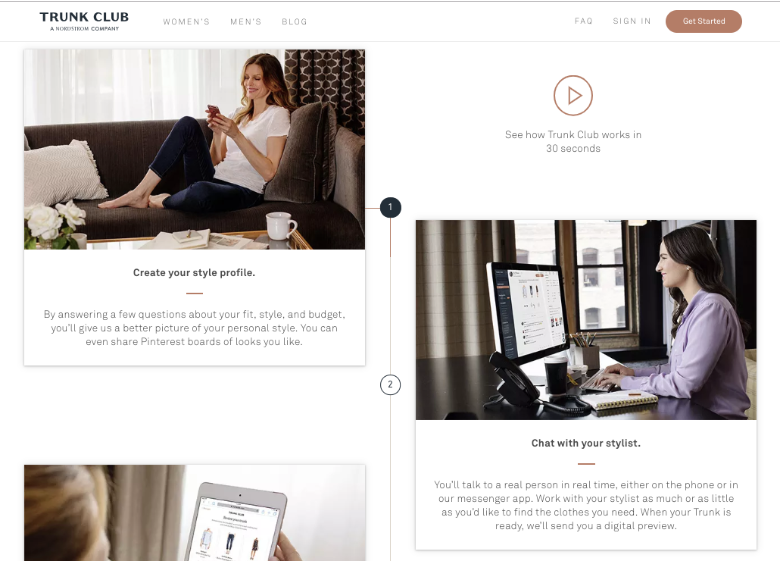
A customer creates a style profile and chat with a stylist. Then a stylist sends a digital preview to the customer. The customer then has 48 hours to approve or change the contents of the trunk. Once it’s approved, the customer receives their trunk from UPS in 4-6 business days.
Shipping is free, and trunks ship anywhere in the contiguous United States. Once the trunk arrives, the customer has five days to decide what they want to keep and what they’ll return. A $25 styling fee (waived for Nordstrom cardholders) is credited towards the purchase. Returns are free, simply ship it back with the included return label. Customers can order occasionally or can set up monthly or seasonal trunk deliveries.
Trunk Club also provides additional information to common questions, such as costs, styles, and more.
Warby Parker
Warby Parker is another great example of an online company using the try before you buy model. As Mashable points out, The company offers affordable designer glasses. Two Wharton School students founded the company in 2010. They found out that most of the “designer” glasses are simply licensed to a few giant eyewear companies and sold in bulk to optical shops. They cut out the middleman by designing their own glasses. By also selling them online, they were able to offer designer eyeglasses at or a much lower price. Warby Parker also follows the TOMS shoes one-for-one giving model—with every pair of glasses they sell, Warby Parker donate a pair to someone in need.
Warby Parker offers online tools, quizzes, and phone calls with stylists to help customers choose glasses. Then customers are sent 5 sample frames that they choose between. This is perhaps why they’re one of the most well known try before they buy company.

Try Before You Buy Technology
Payment options are key to implementing try before you buy on ecommerce websites. Several companies offer this technology to online companies of all sizes. They include Klarna and Try. Klarna is integrated with top e-commerce platforms, such as Shopify and WooCommerce. Try works with individual retailer websites to add the buy, now pay later option.
Next Steps
If you sell online apparel or accessories, consider implementing the try before you buy option. Consumers love it, and there is a growing trend of companies who successfully use this payment option. It might make the difference between good and great sales and profits!
Pros and Cons of Implementing a “Try Before You Buy Option”
We will discuss the pros and and cons of implementing a try before you buy option in your online store.
PROS
Let’s look at the factors leading to this interest.
The growing trend of buying multiple items with the plan to return some
More and more customers are purchasing more items than they plan on keeping. Depending on your returns policy, you could end up losing money on a purchase. Below is a recent report from Brightpearl that shows the trends of different age groups and what percentage that submit partial returns.
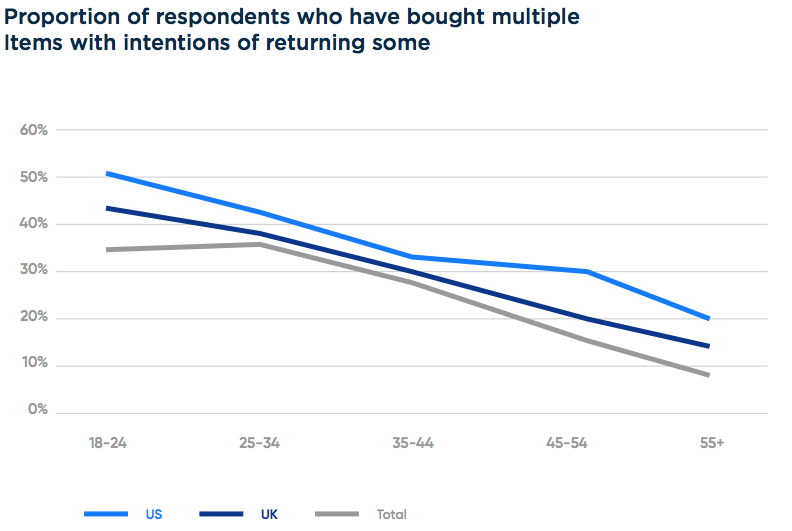
In Brightpearl’s survey of online shoppers, a large portion of U.S. respondents said that they have bought multiple items with the intention of sending some back. (Younger shoppers tending to create partial returns at more than twice the rate of Americans 55 and older.)
The continued increase in the number of online returns
Ecommerce returns are growing rapidly. They have increased 94.8% over the most recently measured five-year period, according to a recent Shopify report.
Post-purchase solutions provider Narvar offers additional insight from its survey findings:
- “Nearly half (48%) of shoppers surveyed said they returned an online transaction in the last year.” (Narvar.com)
- “49% of shoppers actively check the retailer’s return policy before completing an online transaction.” (Narvar.com)
- “Apparel was the category that respondents said they returned the most (43%).” (Narvar.com)
Online shoppers’ attitudes about Returns
- “A significant portion of those surveyed say that restocking fees (84%) or return shipping fees (74%) will prevent them from making a purchase.” (Narvar.com)
- “29% of shoppers Narvar surveyed said they worry their return will be lost in the mail” (Narvar.com)
- “21% found it frustrating to check on the return status” (Narvar.com)
- “48% of shoppers aged 21 to 29 say that online returns are a hassle” (Narvar.com)
Consider Implementing a Try Before You Buy Option
The try before you buy option allows online shoppers to duplicate the brick and mortar experience of trying on items before buying. There are strong cases for implementing try before you buy. For one, shopping online is incredibly convenient. There has been an increase in consumers buying multiple items with the intent to return some. There is an increase in online returns, as well as dissatisfaction in many return policies.
CONS
With so many reasons to implement a try before you buy option, why wouldn’t you?
According to a recent report released by Brightpearl, the main reason is the potential cost to your business.
How Will Try Before You Buy Cost Your Business
The Brightpearl study, which includes the opinions of 200 retailers and 4,000 consumers in the United States and UK, shows that the growing trend of try before you buy (TBYB) will have a major impact on both purchase behavior and returns:
- 25% of retailers globally will adopt online TBYB by 2019, but the majority are unprepared for a surge of returns that could QUADRUPLE return costs for US retailers
- US shoppers offered TBYB would buy on average five extra items each month (but 87% would return up to seven items)
- 44% of retailers say their margins are being strongly impacted by handling and packaging returns (70% say they will be squeezed further with the increase of TBYB)
- Small-and-medium-sized retailers are most at risk, with 70% worried that TBYB services will affect their business
- Almost two thirds of US retailers are not using technology solutions to process returns
These are scary statistics. A ray of hope is offered by Gareth Austin Jones, of footwear brand Cocorose London. “For retailers to capitalize on Try Before You Buy without cannibalizing margins, they need the right systems in place to optimize the returns process and ensure end-to-end visibility over factors such as available cash flow and inventory in the system—all of which could cause major pain points. If they don’t prepare now, the impact on return rates could devastate online retailers that are already seeing their margins considerably squeezed.”
How to Minimize Returns
Brightpearl recommends using technology and automation to prevent the “tsunami of returns” from crippling businesses, including:
- Obtain information about items that have been kept or returned in the past, to make changes to product lines or inventory
- Centralize data to identify fraudsters earlier
- Automate returns to decrease human error, time spent on processing returns and get products back into inventory more quickly
Another potential issue? Getting paid. In a brick and mortar store, shoppers try on items and pay before they leave the store. For online retailers, it’s risky to send things to shoppers without paying.
Technology again helps make this process easier. Payment options such as Klarna allow retailers to get paid when items are ordered. Shoppers are also protected. Klarna’s Buyer Protection Policy promises customers they will only pay for items they purchased. They will always receive their money back if their purchase doesn’t arrive, they receive items they didn’t order, or if items are defective, damaged, or do not meet the merchant’s description.
Next Steps
The try before you buy option is a growing trend among e-commerce companies. Shoppers love it, but online sellers need to carefully consider the ramifications of implementing it. The increase in sales is great, but you must have systems in place to handle the additional returns, without breaking the bank.


